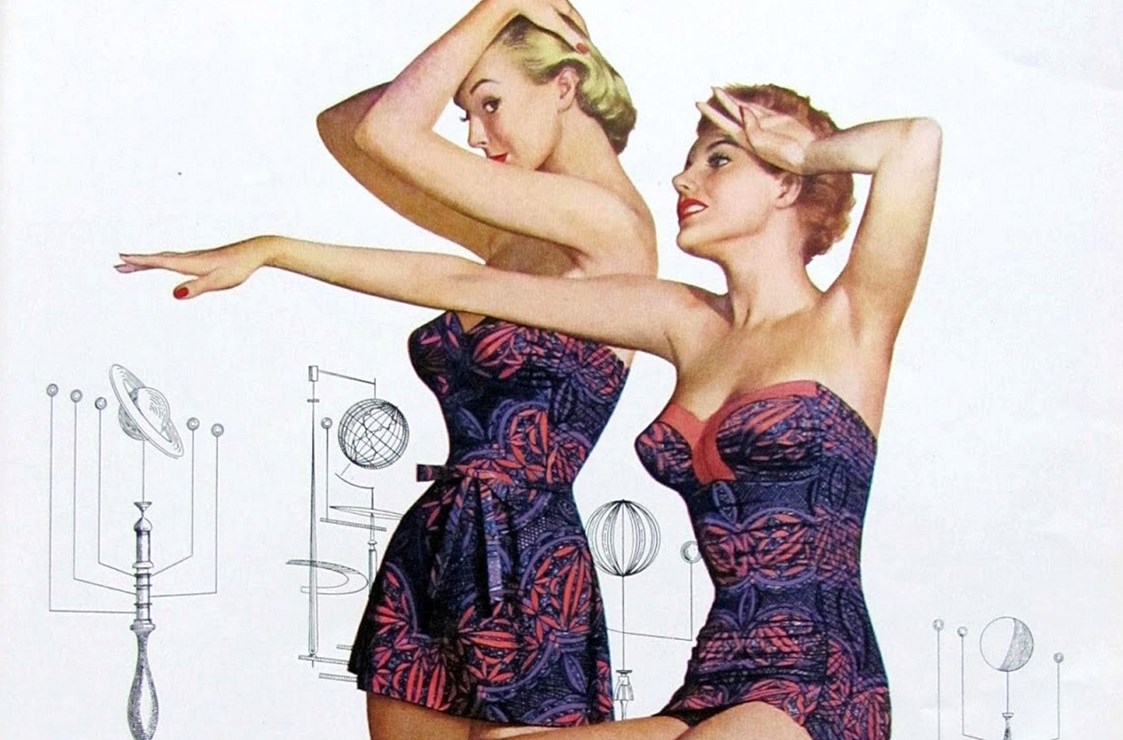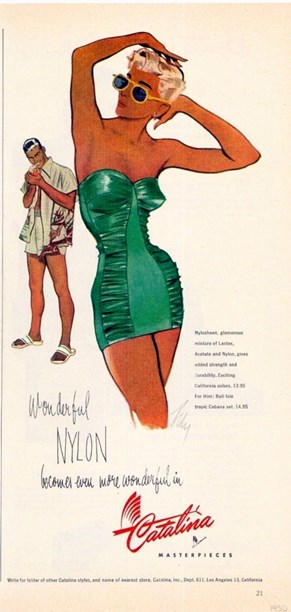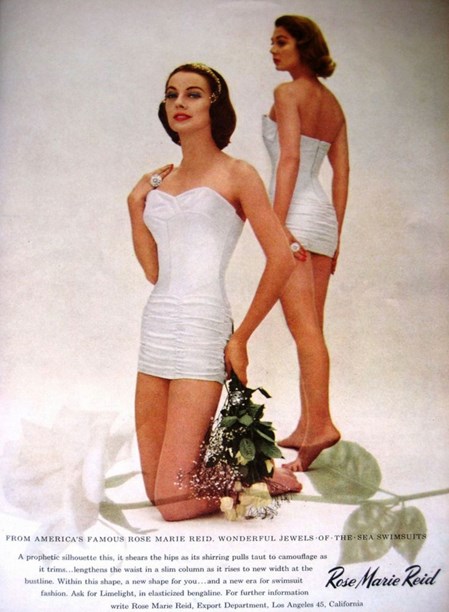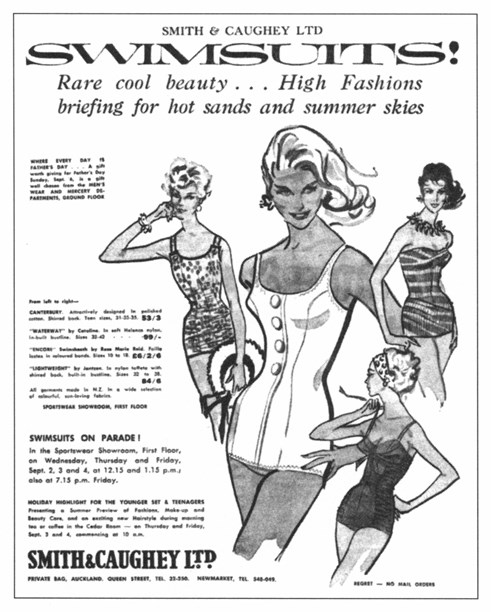Stories
The 1950s Glamour Swimsuit
1950s

The Hollywood-inspired one-piece swimsuits of the 1950s gave New Zealand women the opportunity to enter a glamorous world of escapist fantasy. Going to the 'pictures' (New Zealand-speak for 'movies') was one of the main forms of entertainment and women aspired to the Hollywood Look, on the street, on the beach and on the dance-floor.
While import licensing, which was introduced in 1938, curtailed swimwear imports, it did result in New Zealand manufacturers acquiring licences to produce the leading brand American swimsuits here, using the original patterns and fabrics. As many of these brands had Hollywood connections, their availability in New Zealand brought the big-screen dream a little closer to reality.
Advertised as 'the top swimwear brand to the stars', Catalina, founder and sponsor of the Miss USA and Miss Universe pageants, was made in Christchurch by Lane Walker Rudkin, home of Canterbury swimwear. Holeproof Industries picked up Rose Marie Reid whose swimsuits were worn by Rita Hayworth, Marilyn Monroe and other Hollywood icons. A J Coleman manufactured the Jantzen brand.

Catalina swimsuit advertisement from the 1950s. Catalina had a global reach that included New Zealand, hence the company slogan: 'Around the World – it’s Catalina'.
Due to assiduous promotion, Cole of California, which enjoyed a long association with Olympic swimmer-turned-movie-star Esther Williams, had a high profile in New Zealand. In 1951, the licensee, California Fashions Ltd, placed this advertisement in The Mirror magazine: 'MISS COLE OF NZ CONTEST. A nation-wide contest will be held this year to find the girl most suitable to represent NZ in California. The winner will receive a free wardrobe and an air trip via Honolulu to California for two weeks holiday, including a tour of Hollywood and the M.G.M Studios ...' Entries were to be accompanied by a photo of the entrant in a Cole of California swimsuit.
Referring to the overall importance of the swimsuit, Cole of California’s promotional material included the comment: 'Never in the history of mankind has so little done so much for so many'.
The original American advertisements promoting the swimsuits, sketched or on live models, also made their way to New Zealand, with space left at the bottom for stockists to add their own logos. The Jantzen ads were particularly notable for their illustrations of women with Barbie-esque figures cavorting on the beach with tanned-to-the max Ken doll lookalikes.

1950s Jantzen advertisement for a black Lastex faille swimsuit with white contrast trim. As was the custom with all Jantzen swimsuit advertising, it emphasises the exuberant, outdoor California lifestyle.
Constructed like a corset, which it closely resembled, the 1950s’ glamour one-piece streamlined the hips, attenuated the waist and emphasised the bust. Bust sections were padded, under-wired, cupped or uplifted. Straps were often detachable to avoid visible tan lines. The torso was boned and seamed to increase body definition and fastened at the back with an industrial-weight hook and eye and a zip. Stretch control panels were incorporated to flatten the tummy.
The cling-fit was made possible by the use of Lastex, an elastic two-way stretch textile made from latex (rubber) combined with other yarns such as cotton, rayon, silk or nylon. While elasticised fabrications such as rib knitting and elastic shirring began to be used for swimwear in the late 1930s, it was the 1950s that saw them mastered.
Cut straight across the leg and gently curved at the top, the 1950s’ one-piece, although undeniably seductive, appears somewhat modest by modern standards. Its allure lay, not in plunging necklines and high-cut legs, but in the delineation of the female form.
The boned, strapless version bore a likeness to the fashionable eveningwear of the period. With the addition of a long full skirt, and accessorised with elbow length gloves and high heels, it could have gone to a ball. Ruching, a predominant style feature, harked back to the evening gowns of the 1940s.

1950s advertisement for ruched, strapless one-piece swimsuits by Rose Marie Reid who believed a woman should feel as glamorous in a swimsuit as she did in an evening gown.
This wasn’t the first time eveningwear influenced swimsuit design. 1930s’ swimsuits similarly drew inspiration from the prevailing evening dress silhouette. Backs were bared to the waist and suits were lean and sometimes cut on the bias, a line diagonal to the grain of a fabric, for a sleeker fit.
Sunfrock details, such as cuffed tops, bows, buttons and shirring, were referred to as well, producing a playful look that was more ingénue than sophisticate. Variations on the theme included ruffled skirts and the romper bottoms made popular by American fashion designer Claire McCardell in her much lauded swimsuit and playsuit collections.
The Summer 1959 issue of Vogue New Zealand advertised Jantzen and Rose Marie Reid swimsuits and featured them in an editorial. In its early days, the magazine was compiled in England which probably accounts for a reference to the one-piece suit as a maillot, a French term that would have been unfamiliar then, to most New Zealand readers.
Compered swimsuit parades were held regularly in department stores throughout New Zealand, usually between 12pm and 2pm to attract the lunch-time crowds, and on Friday evenings for the benefit of late-night shoppers. Aucklander Pauline Cardon, who began modelling in the late 1950s, took part in swimsuit parades at Milne & Choyce, Smith & Caughey’s, John Courts, George Courts and the Auckland Easter Show. She says models never went barefoot. As in beauty contests, they were obliged to wear high heels. In 1959, Arlene Nesbitt, the fourth runner-up in the Miss USA pageant, visited New Zealand. Pauline was among the local models recruited to appear alongside the American beauty in swimwear parades staged by major department stores around the country.

Smith & Caughey’s advertisement featuring swimsuits by Canterbury, Jantzen, Catalina and Rose Marie Reid. The New Zealand Herald, September 1959.
An American statistic from the late 1950s, showing that 65-75% of swimwear never saw the water, gives credence to the assumption that the glamour suits were designed as much for display and parading on the beach as they were for taking a dip. Also synonymous with 1950s’ beach chic were full makeup and well-behaved hair, the trademark of Esther Williams of Hollywood aqua-musical fame, an exemplar of impeccable grooming even when dripping wet.
Because of the sturdy materials and construction, the 1950s’ one-piece swimsuit flattered most body types and minimised figure imperfections.
Its glamorous image and capacity to accommodate, moderate and celebrate female curves has ensured its longevity. The silhouette remains the style of choice in everything from burlesque to the vintage clothing trade and Miss Pin Up competitions.
As an ad of the day put it: 'Our suits are controlled from within to put every inch you own in just the right places'. Who can argue with that?
Text by Cecilie Geary. Last published October 2017.